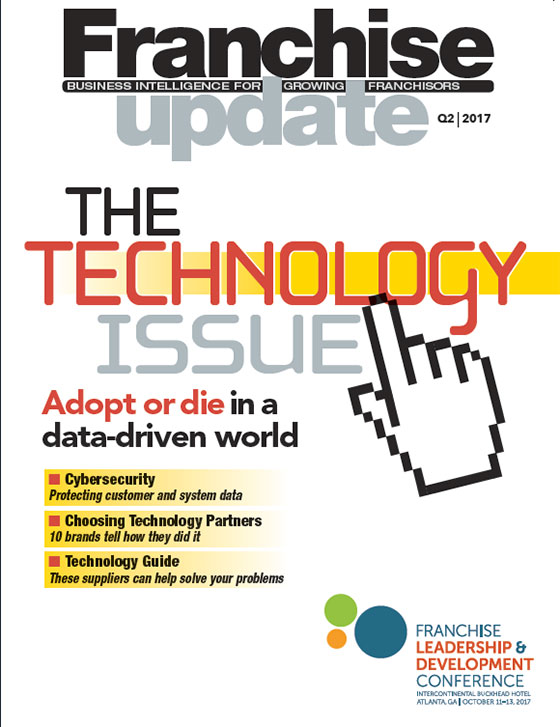Choosing Technology Partners

How 10 brands upped their tech game
Craig Ceccanti could be the Clark Kent of franchise software development. Beneath his everyday garb as CEO and co-founder of Pinot's Palette lies his hidden superpower: a double major degree from LSU in computer science and information systems, strengthened by seven years as a software developer for major clients, including the Florida House of Representatives.
When Ceccanti wants to build or update the software at Pinot's Palette, he and Charles Willis--Pinot's co-founder and president, as well as an electrical and computer engineering major in college--do it in-house.
Yet that's not what he recommends for 90 percent of his colleagues in franchising. Ceccanti coaches some of those colleagues and his advice is simple: If the choice is between building or renting software, rent. "Most people don't understand the full cost of buying," he says. "But to be successful whether you build or rent, you need to have some core competencies in technology."
Without that, navigating the addition of new technology for a franchise operation can seem like moving to a new town without friends or family. It's an unfamiliar landscape that, fortunately, can be transformed with smart decisions to help avoid dead-end streets and potholes. It's not easy or simple, but without exception, adding new technology to franchise operations is worth the effort.
Painful first steps
If Ceccanti's story represents perfect circumstances, Ron Holt's tale is the imperfect followed by a grand recovery. Holt, CEO and founder of Two Maids & A Mop, wanted to give his residential cleaning customers the speed and convenience of online scheduling and payment.
Holt was not a complete technology novice. He had already embraced the use of Facebook, Instagram, and Pinterest. The feedback from those social media platforms allowed him to evaluate traffic from those sites and follow a customer from first social media visit to appointment. He wanted more, but had few other industry-specific examples to follow. "The residential cleaning industry is 90 percent mom-and-pop, so there's been very little technological innovation. I saw the opportunity to create new technology that would give our business an advantage," he says.
To build the new software, Holt chose a firm about two blocks from his office. "We felt it would be important to work with a local firm because we assumed there would be hours and hours of face time needed to complete the project," he says.
That assumption turned out to be wrong: Holt discovered that 95 percent of his communication with the firm could be done online. He also learned that he had gone into the project with his "eyes not quite open," he says.
"I am not a software guy and I was naive early on about what the project would entail. I assumed there would be some flexibility with the contract," he says. "That naiveté turned into realism very quickly. We were billed for our time beyond what we thought would be our cost." The software delivered to Holt from the outside vendor took 18 months instead of the promised six and cost him $500,000, instead of the $150,000 he initially expected.
Finally, Holt made a hard decision: he hired two developers to work in-house. That decision wasn't without some anxiety, however. "When you go into this blind and it's a completely foreign subject to you, it's overwhelming and scary," he says. "At one point, we considered giving up."
Those painful first steps, however, did finally bring him the business advantage he sought--including additional, unanticipated benefits. For example, he says, "If our in-house team has a good idea, we can make abrupt changes. If we were still using an outside firm, that change would cost us." In some ways, he says, the new software is working too well. "We have a mechanism where you can report bugs and request new features. Now one of our biggest struggles is how to manage all those requests!"
The new software also has added new business options for customers, who can now connect with housecleaners willing to work weekends or evenings. Customers also can adjust the frequency of visits outside the more common schedule of weekly, biweekly, or monthly visits. The software also is guiding route mapping to reduce employee travel time.
Now that he's learned his rookie lessons, Holt has packaged and branded the software so it can be used by other service industries. And he has that proximity he sought initially: "Now we can literally walk across the building to talk with our in-house software developers," he says.
He does offer a few words of advice to others. "Work with a consulting firm or a software engineering firm to help you build the plan for the project--then use that plan to execute the hiring. You have to have a clear, realistic, and well-scoped plan because no project will go perfectly."
Specialized expertise
Always Best Care, a home healthcare service and assisted living facilities brand, faced an additional challenge in building a system: stringent and complex regulations governing its delivery and reimbursement. In such a highly regulated environment, it's hard to believe that as recently as 10 years ago the company did everything on paper.
The introduction of an electronic medical record (EMR) system in recent years made it possible to track patients, medications, doctor instructions, and hospital records. Patient referrals could be centralized, diagnosis and billing coding insertion automated, and documentation of all patient care information improved in accuracy. But building electronic medical record software is not an in-house project.
Wading through the complexities involved in adding new technology in the healthcare field was made easier by industry resources such as the conventions organized by the National Association of Home Care & Hospice and the Home Care Technology Association of America. An annual home health technology summit is another chance for people like Elizabeth Brennan, vice president of area operations at Always Best Care, to scope out technology options from firms with specialized knowledge of the rapidly changing healthcare industry.
Brennan understood that the brand needed two important additions to its technology: 1) financial benchmarking, and 2) direct digital communication with referring medical providers and payers. The benchmarking software, built by a firm she found by exploring established, industry-recognized companies, allows ABC to privately compare its performance with that of others in the industry. It can compare, for instance, percentages of expenses allocated to similar line items at its benchmark companies. That information, Brennan says, "told us we're not spending enough to fuel our business." The software also shows her where coaching and training might be required.
The next step, she says, is to use the EMR system and new software platform to create system-wide communication portals to improve the interface between healthcare professionals and payers. Healthcare systems are growing and prefer to work with like-sized systems, not the mom-and-pop facilities that once dominated the market.
"We have to stay on top of where the industry is going," says Brennan, "or we lose our competitive advantage."
Kick the tires
Yona Smith, franchise development marketing and sales manager for Homewatch CareGivers, began with vendors recommended by industry colleagues, but took the evaluation one step further: she and her team compared demo performances of software offered by several vendors. "My team made a checklist of items we had to have versus items that were 'nice to have.' The vendor we selected had them all," she says. That vendor offered an additional benefit: one-on-one training for the team.
The new lead management system Smith's team approved has been up for only a couple of months, but she is pleased with the results so far. "Our franchise candidates are very impressed with the new online candidate portal. It allows my team to make instant updates on the fly, and allows our candidates to navigate the process themselves very easily with or without a sales representative," Smith says. "The new system is definitely more complex but has a lot more bells and whistles."
Narrow it down
Before seeking help from third parties, Chicken Salad Chick looked at the pain points generated by the company's essential tasks from two points of view: 1) What was taking a long time to do?; and 2) What wasn't easy to execute?
"There are people and companies that can do this better and quicker than we could," says Ali Rauch, director of marketing at the brand. "Sometimes the hardest part is accepting you can't do it all." The company worked hard, however, to build a robust compare-and-contrast list of possible vendors. "Slowly but surely, we check vendors off the list until we find the right one," says Rauch. "It can be a time-consuming process, but it's worth it."
The results of that winnowing process have been very satisfying. "When we selected Reputation.com to manage all of our listings and reviews, one deciding factor was the mobile app they have that allows every one of us to receive and respond to reviews and social comments from one consolidated place--and where our owners and managers need to access it--on their phones," says Rauch. "It has made life easier and fulfilled our need."
Phase it in
In her early days with the brand, Nancy Bigley, CEO of Bottle & Bottega, knew what she wanted--and it was a tool crucial to the success of her small start-up brand. "I had a very specific vision for the experience I wanted our candidates to have as they evaluated our business. It was the same journey I went on when evaluating whether to buy into the company or not. We are a painting and wine party business, so I had to make our studios and the guest experience come to life for them since we were brand new and only had one location at the time." In those beginning days, she says, "Every dollar we spent had to count."
Bigley phased in the new technology, with the scope of work at each phase representing movement toward the long-term goals of her vision. That meant many phone calls to answer questions about functionality, she recalls. That level of specificity and interaction between vendor and client at each phase sometimes meant the vendor would catch something she didn't think about. "That helped us end up with a final scope of work that is pretty complete."
She also viewed the new platform as a work in progress. A year-one evaluation showed some areas for improvement. "Year two, we went back to the system and really tricked it out and took the design and questions to a completely different level," she says. "I've built out enough technology systems to know your first pass is not your last. It's your tester platform. I'm a believer that you have to walk before you run and make mistakes and go through a little pain to understand ultimately where the sweet spot is. One key piece of advice, she says, is to keep technology upgrades simple in the first phase, to learn what needs to be improved in the ensuing phases.
Two-vendors solution
Tropical Smoothie Cafe recognized that updated technology was essential to keep up with the brand's evolution from smoothies-only to smoothies and a full line of food. It wasn't a straightforward transition, combining a high-frequency product with fast casual-paced products such as wraps, flatbreads, and sandwiches. One thing that was certain, however: customers wanted to customize their orders and do that with a mobile app.
Tropical Smoothie used two vendors to solve this problem. One tool hones in on customer performance, tracks purchase behavior, check average, and frequency; it also highlights opportunities around increasing user visits and spending through targeted campaigns along with a distinct loyalty program, says Kira McCabe, the brand's associate director of digital media. "The other software delivers directly to our cafes and assists in line management, order accuracy, and labor overhead," she says. "With both of these tools we are able to view into guest behavior, check size, and purchasing preferences in the cafes. Before our new technology, that wasn't possible."
An eye to the future
Sport Clips President Mark Kartarik had ambitions for the brand that could only be achieved through new technology. "We wanted to allow our clients to be able to check in online, see wait times on a fully integrated digital display wallboard, select specific stylists, and most importantly, manage their time by choosing where they want to wait for their service," says Kartarik. He also monitors the technology available for hairstyling businesses and selected a vendor that not only had the best existing solutions, but also was willing to innovate to suit the needs of the brand and its customers. His technology goals, just halfway through implementation, are like Holt's: first of its kind to offer all capabilities at all locations. "The early feedback," he says, "has been overwhelmingly positive."
Get the help you need
For Jonathan Barnett, founder and president of Oxi Fresh Carpet Cleaning, the results of its technology update have been spectacular. In its early years, Oxi Fresh's job data was entered into spreadsheets manually. As the company grew, Barnett realized he needed a tool that would scale, automate, and streamline the process.
Like Brennan at Always Best Care, Barnett had the advantage of finding help at industry conventions. He also networked the question. He found the right company to begin the process, but has since hired a programmer. The transition from spreadsheet to CRM platform was so dramatic that Barnett said evaluation wasn't needed. But some numbers help.
"Since implementing the software, we've scheduled well over half a million jobs in it," Barnett says. "And during our busy season, the Scheduling Center handles up to 2,000 calls a day. We went from adding up job values and durations by hand to a system that calculated all of that for us. The time saved alone made the transition worth it."
Patience pays
Sometimes, one technology must wait for others to develop. Salomon Mishaan founded OXXO Care Cleaners more than 15 years ago with new, innovative ideas about dry cleaning. Not only did he want to make the process greener, he also thought that the 24-hour drop-off and pickup doors he'd seen in Europe would make sense in the U.S. They were a hit--the first such to be available at dry cleaning franchises--but not until Skyping and mobile apps became available could he offer his customers a communication method that matched the convenience of the 24-hour doors.
To complete his customer service vision, Mishaan stuck with the same developer that had produced his point-of-sale software. The resulting app allows customers to use their phones to retrieve their clothing and receive notices tracking the status of their garments throughout the cleaning process. The app also allows OXXO to send customers coupons and for customers to share their comments online.
The app is still in its beta phase, but Mishaan knows customers are happy to trade their OXXO card for a smartphone app. And he's not finished innovating. For example, drones could make deliveries--OXXOdrones, he jokes. But maybe it's not so wild an idea. "When we talked about the 24-hour door all those years ago, people said, 'Wow,'" he recalls. Now they're in all 50 of OXXO's stores.
Share this Feature
Recommended Reading:
FRANCHISE TOPICS
- Multi-Unit Franchising
- Get Started in Franchising
- Franchise Growth
- Franchise Operations
- Open New Units
- Franchise Leadership
- Franchise Marketing
- Technology
- Franchise Law
- Franchise Awards
- Franchise Rankings
- Franchise Trends
- Franchise Development
- Featured Franchise Stories
FEATURED IN

Franchise Update Magazine: Issue 2, 2017








 The franchise listed above are not related to or endorsed by Franchise Update or Franchise Update Media Group. We are not engaged in, supporting, or endorsing any specific franchise, business opportunity, company or individual. No statement in this site is to be construed as a recommendation. We encourage prospective franchise buyers to perform extensive due diligence when considering a franchise opportunity.
The franchise listed above are not related to or endorsed by Franchise Update or Franchise Update Media Group. We are not engaged in, supporting, or endorsing any specific franchise, business opportunity, company or individual. No statement in this site is to be construed as a recommendation. We encourage prospective franchise buyers to perform extensive due diligence when considering a franchise opportunity.